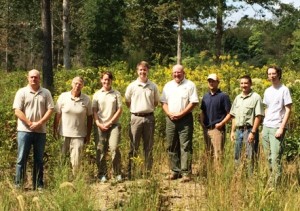I am trying to sit here and reflect back on the year in human terms. Trying to take stock and put into words so many intangible things that we do not report, so many things that are hard to put numbers on, and trying to figure out how I report on the human spirit.
You see we have a team of people that are self-motivated to do a great job. Our team of five private lands wildlife biologists routinely challenges themselves to learn more and improve our program. No one made anyone develop a Facebook page, they took that upon themselves. No one required them to re-work our quail web page, they saw the need and did it. No one made one of them try radio advertising as an outreach tool, but he did. No one forced them to become plant identification experts, or cost-share program gurus, it was simply in their DNA to strive to be better and to help each other along the way.
That is what I would call a team. And all we have done to help is foster an atmosphere that encourages initiative. We have tried to give them the tools and equipment they need to succeed. And we have tried not to stand in their way when ideas develop. We have encouraged each one of them to excel in the areas in which they wish to excel.
As time has passed, we have also started developing training opportunities that go beyond the basics for them. This year our quail team, along with several Ft. Pickett natural
 |
|
resources staff, spent nearly an entire day in the field with Dr. Theron Terhune – Game Bird Research Program Leader at Tall Timbers Research Station. Theron was nice enough to spend hours with us touring the habitat on Ft. Pickett and answering questions and sharing his knowledge. It is hard to put a price tag on that experience. Thanks, Theron!
We also spent a day with VDGIF’s long-time forester, Kent Burtner. Kent was kind enough to drive down from Verona on a very hot May afternoon and teach our team all about cruising timber. For the uninitiated, that does not mean driving a log with wheels and power steering. Cruising timber is how foresters estimate the value and volume of a timber stand. It is critical to properly marketing a timber tract. Why is this important to our quail team? Most landowners we work with have timber of some kind and our team needs to be able to “talk the talk and walk the walk.” It is part of credibility and being able to relate to landowners. If you show up on a property and you don’t know what “board feet” is, or how trees per acre relates to basal area, that landowner may look at you and wonder if you really know anything about quail, either.
The team also spent two days on a specially arranged trip to the University of Tennessee, Knoxville to visit with Dr. Pat Keyser, and his team at the Center for Native Grasslands Management. Dr. Keyser has done a ton of work with native grasses on working landscapes. How can we integrate cattle and quail? His research is showing that moderate levels of cattle grazing, even during the primary nesting season, actually improves native grass stands for quail and some songbirds. Left to their own devices, many native grass stands become too thick for bobwhites. What better way to manage them than a method that puts pounds on steers at the same time? Our team is out front on issues like these.
We’ve also stepped up to lead by example at the national level. Seven of our team members participated in the 21st National Bobwhite Technical Committee meeting in Galloway, New Jersey this August. Participated is the key word because we never simply “attend.” For many years Virginia has held leadership positions on the steering committee of NBTC. That continues. This year one of our team members stepped up to become vice-chair of the Outreach Subcommittee (to become chair in two years), and another now serves as chair of the Research Subcommittee and continues to play a key role in the implementation of NBCI’s Coordinated Focal Area Program. I have one more year as past-chair and that will wrap up a six-year term for me that began in 2010. All our team members play active roles on NBTC committees. And team member Bob Glennon was presented the NBCI National Firebird Conservation Award for Virginia this year for his never-ending energy in teaching and mentoring us all.
Where am I going with all this? Not much further. I hope the point is well taken. You can’t compare Virginia’s habitat potential to states like Texas, Georgia, or Florida. That’d be like trying to compare taste between a Georgia Peach and a Virginia Honey Crisp apple. Virginia is Virginia and we are doing our best and always striving to improve. We are proud of our team and of what we have done.
September 14, 2015


